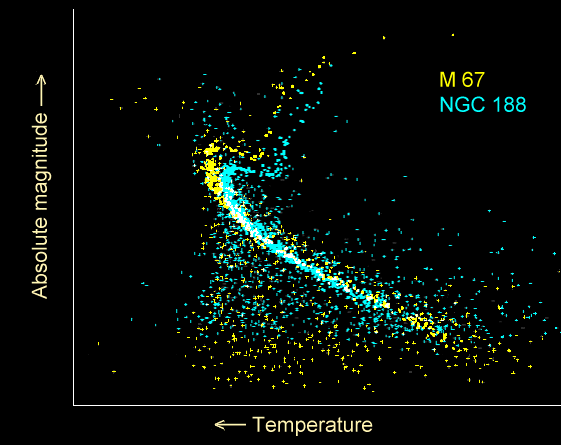 |
This is a file from the Wikimedia Commons. Information from its description page there is shown below.
Commons is a freely licensed media file repository. You can help.
|
 |
This image was (or all images in this article or category were) uploaded in the GIF format, while a different format would have been more suitable. Commons discourages the use of GIF files, except for animations. See Commons:File types for more information. If possible, please upload a PNG version (or JPEG for some photos) of this image, and mark the GIF image as {{ superseded|Image:new image name}}. If you like, encourage other Wikimedia projects using the GIF to use the new version instead.
If this image is a diagram or other image suitable for vectorisation, please tag this image with {{ convert to SVG}} instead of {{ badGIF}}. If not suitable for vectorisation, use {{ convert to PNG}}.
|
Summary
| DescriptionOpen cluster HR diagram ages.gif |
English: HR diagrams for two open clusters, showing the main sequence turn-off at different ages.
|
| Date |
|
| Source |
Own work |
| Author |
Created by User:Worldtraveller |
Reference
- Richmond, Michael (2004-12-28). Estimating Distances across our Galaxy. Rochester Institute of Technology. Retrieved on 2008-11-29.—See the two plots near the end of the page.
- Maeder, André (1974). " Stellar evolution near the main sequence: on some systematic differences between cluster sequences and model calculations.". Astronomy & Astrophysics 32: 177–190. Retrieved on 2008-11-28.
Licensing
 |
Permission is granted to copy, distribute and/or modify this document under the terms of the GNU Free Documentation License, Version 1.2 or any later version published by the Free Software Foundation; with no Invariant Sections, no Front-Cover Texts, and no Back-Cover Texts. A copy of the license is included in the section entitled GNU Free Documentation License. http://www.gnu.org/copyleft/fdl.htmlGFDLGNU Free Documentation Licensetruetrue
|
File usage
The following pages on Schools Wikipedia link to this image (list may be incomplete):
SOS Children chose the best bits of Wikipedia to help you learn. SOS Children's Villages helps more than 2 million people across 133 countries around the world. There are many ways to help with SOS Children.




